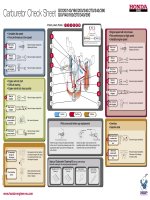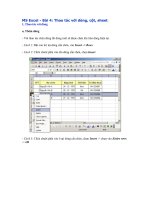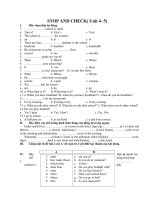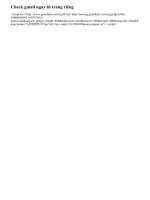Onboard Routine Maintenance Check Sheet
Bạn đang xem bản rút gọn của tài liệu. Xem và tải ngay bản đầy đủ của tài liệu tại đây (580.74 KB, 34 trang )
Onboard Routine Maintenance Check Sheet
February 2009
Our Mission
The mission of ABS is to serve the public interest as well as the
needs of our clients by promoting the security of life, property
and the natural environment primarily through the development
and verifi cation of standards for the design, construction and
operational maintenance of marine-related facilities.
Quality & Environmental Policy
It is the policy of the American Bureau of Shipping to be
responsive to the individual and collective needs of our clients
as well as those of the public at large, to provide quality services
in support of our mission, and to provide our services consistent
with international standards developed to avoid, reduce or
control pollution to the
environment.
All of our client commitments, supporting actions, and services
delivered must be recognized as expressions of Quality. We
pledge to monitor our performance as an on-going activity and
to strive for continuous improvement.
We commit to operate consistent with applicable environmental
legislation and regulations and to provide a framework for
establishing and reviewing environmental objectives and
targets.
ONBOARD ROUTINE MAINTENANCE
CHECK SHEET
FEBRUARY 2009
American Bureau of Shipping
Incorporated by Act of Legislature of
the State of New York 1862
Copyright © 2009
American Bureau of Shipping
ABS Plaza
16855 Northchase Drive
Houston, TX 77060 USA
Disclaimer
Use of this check sheet is neither a classification nor a statutory requirement. This check sheet is provided to owners to use in drafting and
refining their own operation and maintenance procedures. This check sheet has not been developed for any particular ship or type of ship.
As it is based on observations during surveys, inspections and audits, the checklist may include items which do not apply to a particular ship
and may omit items which do apply.
Limitation of Liability
If any party using this check sheet relies on any information or advice given by ABS, and suffers loss, damage or expense directly thereby
which is proven to have been caused by the negligent act, omission or error of ABS, its officers, employees or agents, or from breach of any
implied or express warranty of workmanlike performance in connection with the services, or from any other reason, then the combined
liability of ABS, its officers, employees, agents or subcontractors to the client or any other person, corporation, partnership, business entity,
sovereign, country or nation, will be limited to the greater of a) $10,000 or b) an amount equal to ten times the sum actually paid for the
services alleged to be deficient.
ABS shall in no circumstances be liable for indirect or consequential loss or damage (including, but without limitation, loss of profit, loss of
contract, loss of use) suffered by any person resulting from any failure by ABS in the performance of its obligations in preparing this check
sheet. Under no circumstances whatsoever shall any individual who many have personally caused the loss, damage or expense be held
personally liable.
Nothing in this check sheet shall be deemed to create any interest, right, claim or benefit in any insurer or other third party who has not
received this check sheet directly from ABS. It is understood and agreed that nothing expressed herein is intended or shall be construed to
give any other person, firm or corporation, any right, remedy or claim hereunder.
ii
February 2009 • ABS Vessel Routine Maintenance Including Check Sheet
iiiABS Vessel Routine Maintenance Including Check Sheet • February 2009
INTRODUCTION
ABS is committed to promoting the security of life at sea, of property and of the natural environment. It believes
that an important element in achieving these goals is a well designed and effectively implemented ship mainte-
nance system. A sound maintenance program not only helps address safety, environmental and operational
concerns, but it is a sensible investment in a valuable asset, the ship. With this in mind, the information supplied
in the attached check sheet is intended to assist our clients in fulfilling their commitments to their crews, ships
and the general public.
The attached check sheet has been developed as an aid for crewmembers to use when carrying out normal
routine maintenance for their ship. Completion of the check sheet is not a requirement of class, nor required
by any flag or port State authority. It is merely a tool that may be used by the crew as reference for items that
may be overlooked during routine maintenance.
If any item on the check sheet is not in satisfactory condition, then the crew should take appropriate steps to
remedy the condition. However, if the condition is detected while the vessel is on passage and it cannot be
rectified prior to entering port, we suggest to our clients that they notify their owner, ABS, their flag State,
and the port State of the ship’s next port of call; request attendance by ABS; and make a notation in the ship’s
logbook of any action taken.
Additionally, our clients should be aware that Port State Control empowers a State to verify the condition and
acceptability of a foreign vessel using its ports. A port State inspection can identify sub-standard items or
procedures on the ship and the inspector may detain the ship until the specified defects are rectified.
vABS Vessel Routine Maintenance Including Check Sheet • February 2009
SYNOPSIS OF FINDINGS FROM
ROUTINE SURVEYS, INSPECTIONS AND AUDITS
Statutory Certificates, Overdue Surveys
Surveyors, auditors and inspectors routinely review a vessel’s documentation (certificates) to verify that they
have been endorsed for all required surveys during the intervals mandated by the various conventions or class
requirements. Surveys must be completed within the required survey interval for the statutory documents to
remain current.
Cargo Ship Safety Radio Surveys
Common findings recorded in this category relate to main radiotelegraph transmission and reception equipment.
In some cases, the power output of transmitters has been found to be below an acceptable level, causing a reduc-
tion in the range of transmissions. Faults observed in receiving equipment include unsatisfactory reception.
Typical examples of other findings in this category are deteriorated aerials; broken aerial insulators; improperly
rigged aerials for very high frequency equipment; inoperable automatic alarms; defective speakers; and faulty
emergency power sources.
Cargo Ship Safety Equipment Surveys
1. Lifesaving Appliances
Properly functioning lifesaving appliances are key elements of ship safety. Routine crew examinations
and proper maintenance can identify or remedy potential problems, such as structural defects in lifeboats,
inoperative lifeboat engines or flemming gear, missing or inoperative lights on lifebuoys and lifejackets,
excessively worn lifting hooks in lifeboats, missing retro-reflective tape from equipment, badly corroded
engine mounts in lifeboats, missing safety equipment from lifeboats, unsatisfactory “float-free” arrange-
ment on liferafts and inoperative lifeboat launching systems.
2. Firefighting Equipment
It is of utmost importance that the firefighting equipment be properly examined, maintained and ready
for immediate use at all times. Unfortunately, there are many firefighting findings (related to the detec-
tion, extinction or risk of fire) observed during surveys and audits including: missing or holed fire hoses;
missing fire hose nozzles; defective breathing apparatus; excessive oil accumulation in machinery spaces
bilges; broken fire detectors; missing, poorly maintained or uncharged fire extinguishers; holed or soft-
patched fire mains; missing or broken fire station cabinet handles and hinges, wrenches and hydrant
handwheels; unmarked, broken or inoperative fire dampers; unprepared fire and emergency crews;
valves and fittings related to IGS in disrepair; CO
2
cylinder room being used for storage; paints stored
in machinery spaces instead of in a dedicated paint locker; heavy accumulation of grease in galley
exhaust ventilation trunking; seized machinery space skylights; frozen or holed funnel dampers; and
engine room ventilators.
3. Navigation Equipment
During surveys and audits, the types of findings include out-of-date, uncorrected or missing charts for
the intended voyages; inaccurately calibrated magnetic compasses; faulty radio direction finders, echo
depth sounders, radar’s, gyro repeaters, and navigation lights; outdated Tide Tables, List of Lights and
Sailing Directions, etc.; and copies of regulations (e.g., SOLAS, MARPOL, ITU etc.) not on board.
vi
February 2009 • ABS Vessel Routine Maintenance Including Check Sheet
Cargo Ship Safety Construction Surveys
The following findings deal mainly with steering gear and mooring arrangement requirements. Other findings,
which relate to structural items, are discussed under class surveys, hull (below): steering control system malfunc-
tioning; officers not knowledgeable about emergency steering procedures; communications in emergency steering
room not working; anchor chains, windlasses, wire ropes and mooring lines in a deteriorated physical condition
and potentially dangerous; defective guards on winches and windlasses; and missing anchors and chain.
Housekeeping and Fire Safety, Documentation, Manning, Accommodations
1. Manning
The STCW Convention requires that ships have properly trained and qualified crews. These elements of
manning are important because the safety of a ship, its crew, its passengers and cargo and the protection
of the marine environment depend to a large extent on the training, experience and competence of the
crew. The majority of findings in this category relate to the minimum international standards for certifi-
cates issued under the STCW Convention. Each flag State is responsible for establishing the appropriate
levels of the manning aboard ships under its jurisdiction and for issuing each ship with a safety-manning
certificate. Findings in each category include navigational watches stood by uncertified officers, incorrect-
ly endorsed officers’ certificates for the ship they are serving aboard (e.g. oil tankers, gas carriers and
chemical tankers), key officers not in attendence and manning exceeding the numbers listed on the
Cargo Ship Safety Equipment Certificate.
2. Documentation
Statutory certificates are issued to ships in accordance with the various international conventions.
Surveyors, auditors and inspectors have found findings related to a vessel’s certificates including expired
certificates, overdue annual or intermediate surveys, and improperly issued or missing certificates after
a vessel has changed flag from one State to another.
3. Accommodations, Provisions and Working Spaces
Examples of findings pertaining to the crew accommodations include: infestation by cockroaches; blocked
drains; dirty hospitals and bathrooms; leaking toilet piping; missing shower nozzles and controls; broken
or inoperable sinks and toilets; crew members living in hospital spaces; doors to accommodations not
closing adequately; and broken light fixtures and switches. As far as provisions are concerned, the find-
ings usually relate to poor standards of cleanliness. Other findings included in this category are deterio-
rated insulation in galleys that poses a potential health hazard; ineffective or inoperative refrigeration
machinery for cooling storerooms; and insufficient food for the intended voyage. Finally, as far as working
spaces are concerned, findings include lack of adequate lighting and ventilation as well as defective or
missing guards to protect the operator from the moving parts of machinery.
MARPOL Surveys
Careful attention should be paid to pollution prevention measures on board as well as maintaining accurate
records for the handling of oil and other pollutants. Penalties can be severe for an owner and any responsible
crewmembers if a vessel fails to comply with the regulations. Findings noted during surveys and audits include:
missing oil record keeping book or entries not up to date; poorly maintained, misoperating or inoperative equip-
ment for separating oil from water including oil-content monitoring devices; sludge tank connected directly
overboard; and missing or unposted pollution placard.
viiABS Vessel Routine Maintenance Including Check Sheet • February 2009
Load Line Surveys
Surveyors have recorded findings where ventilators, air pipes, watertight doors and hatchways had deteriorated
sufficiently to warrant repairs. These findings could have been avoided by adequate maintenance performed prior
to surveyor attendance. Other findings in this category include: cargo hatch cover securing devices missing or
inoperable; sounding pipe caps missing; air pipes holed; securing devices on weathertight and watertight doors
missing; holed cargo hatch covers; non-sealing weathertight doors; corroded manhole covers; and unsafe rails at
the side of the ship. Other findings associated with the Load Line Convention are discussed under classification
surveys, hull (below).
Classification Surveys
1. Hull
The findings include damage and deterioration of the hull, including items such as distorted bulbous
bow plating and side shell plating deformations; damaged gangways, accommodation ladders, exposed
walkways/platforms, and pilot ladders; corroded cable trays and trunks; faulty closing appliances; serious-
ly wasted, holed, cracked or fractured side frames, transverse deck beams, deck plating, and watertight
bulkheads in the chain locker, forecastle storage space, and engine room; holed vent pipes/closure heads;
holed or damaged hatches; weathertight doors not sealing; overdue special hull surveys; and corroded
access ladders to cargo holds or tanks.
2. Machinery
Surveys that have identified poorly maintained engine rooms list findings such as excessive oil in bilges
and throughout the engine room. Other findings in this category include inoperable remote controls on
boiler safety valves; defective fuel-oil valves on main and auxiliary engines; improperly adjusted steering
gear; accumulation of water leaking on auxiliary engines; frozen or inoperable sea water inlet valves;
defective generators; defective and leaky fuel-oil pumps and poorly maintained air compressors (resulting
in the shortage of starting air for the main engine); leaky or wasted hydraulic lines servicing deck
machinery and cargo hatches; and leaky engine exhaust piping.
3. Cargo Gear
Findings noted during surveys have included: absence of identification marks on hooks, blocks, and
shackles and other small items of equipment; unavailable documentation attesting to examinations
and testing certification; excessively corroded winch bed plates; and winch drums and brakes posing
a danger and requiring repairs.
ONBOARD ROUTINE MAINTENANCE CHECK SHEET
Revision 3 (February 2009) Page 1 of 23
I. CERTIFICATES & DOCUMENTATION
Certificate Expiry Date
Date of Last Survey*/
Endorsement
Comments
AS
Class Certificate
REN
Certificate of Registry
Radio Station License
Safety Radio Certificate PER/REN
MAS
Safety Equipment Certificate
INT/PER/REN
MAS
Safety Construction Certificate
INT/REN
MAS Oil Pollution Prevention (IOPP)
MARPOL Annex I
INT/REN
Carriage of Dangerous
Chemicals in Bulk (BCH or IBC
Code)
MAS
INT
REN
Carriage of Liquefied Gases in
Bulk (GC or IGC Code)
MAS
INT/REN
Carriage of Noxious Liquid
Substances in Bulk (NLS)
MAS
INT/REN
Sewage Pollution Prevention REN
MAS Air Pollution Prevention
MARPOL Annex VI
INT/REN
AFS (Anti-fouling system)
Certificate
Carriage of Dangerous Goods REN
Exemption Certificate (if any) N/A
Load Line Certificate AS/REN
Tonnage Certificate
Document of Compliance (ISM
Code) copy with annual
endorsement
INT
Safety Management Certificate
REN
Ship Security Certificate INT/REN
5 Year Service Lifeboat/Rescue
Boat Launching Devices
5 Year Service Lifeboat On Load
Release Gear
Has the Annual Thorough Exam
been carried out?
Certificate of Service: Liferafts,
Inflatable Lifejackets, Marine
Evacuation System, and
Inflatable Rescue Boat
Does the vessel have proper
certification for the types of
cargo it is carrying per
applicable conventions and/or
codes?
*Survey Abbreviations Defined
AS - Annual Survey
INT - Intermediate Survey
MAS - Mandatory Annual Survey
PER - Periodical Survey
REN - Renewal Survey
This checklist is solely a guidance tool for the use of the ship’s master and crew during routine maintenance and
housekeeping on the ship. Completion of this checklist is not a requirement for class.
ONBOARD ROUTINE MAINTENANCE CHECK SHEET
Page 2 of 23 Revision 3 (February 2009)
II. PERSONNEL CERTIFICATES & DOCUMENTATION
Certificate Issue Date Expiry Date Comments
Minimum Safe Manning
Certificates
Master
Chief Engineer
Officers/Ratings
Engineers
Certificates
for Masters,
Officers and
Ratings
GMDSS Persons
Continuous Synopsis Record
(CSR)
Crew Medical Certificates
III. MANUALS & DOCUMENTS FOR ALL VESSELS
Title Approved By
Document
Language
Crew Language Comments
Stability Information (Trim and
Stability Booklet)
Fire Control Plans
Firefighting Systems and Op.
Training Manual (crew mess/
cabin) and SOLAS training
manuals
Firefighting Systems
Maintenance Plan
Shipboard Oil Pollution
Emergency Plan (SOPEP)
Title Properly Recorded Comments
Oil Record Book, Part I
Garbage Management Plan and
Record Book
Log Book
Lifesaving Appliances
Instructions for On-Board
Maintenance
Title Issued by Examined by Last Endorsement Comments
ACG Cargo Gear
Booklet
Retesting
IV. MANUALS & DOCUMENTS FOR TANKERS & CHEMICAL CARRIERS
Title Approved By Document Language Crew Language Comments
Operation Manual
Oil Record Book, Part I and II
Oil Discharge Manual
Record of Oil Discharge
Crude Oil Washing Manual
For Chemical Carriers
P & A Manual
Title Properly Recorded Comments
Cargo Record Book
V. MANUALS & DOCUMENTS FOR VESSELS CARRYING NOXIOUS LIQUID SUBSTANCES
Title Approved By Document Language Crew Language Comments
Shipboard Marine Pollution
Emergency Plan (SMPEP-NLS)
ONBOARD ROUTINE MAINTENANCE CHECK SHEET
Revision 3 (February 2009) Page 3 of 23
VI. MANUALS & DOCUMENTS FOR LNG/LPG CARRIERS
Title Approved By Document Language Crew Language Comments
Operation Manual
VII. MANUALS & DOCUMENTS FOR VESSELS CARRYING GRAIN
Title Issued By Expiry Date Crew Language Comments
Grain Loading Manual
Certificate Comments
Grain Loading Certificate
VIII. MANUALS & DOCUMENTS FOR SPECIFIC TYPES OF VESSELS
Title
Enhanced Survey Report Files
and Supporting Documents
(ESP, ESDC Vessels)
Damage Control Plan (dry cargo
vessels constructed on or after
1 Feb 1992)
Cargo Securing Manual
Bulk Carrier Booklet per SOLAS
VI/7
Previous Port State Control
Inspection Results
Loading Instrument/Computer
(Required bulk carriers L>150m)
IX. NAUTICAL PUBLICATIONS, INTERNATIONAL CONVENTION DOCUMENTS & FLAG ADMINISTRATION
PUBLICATIONS
Query OK** FIX N/A Comments
Charts (conventional paper
charts)
Up-to date w/latest
corrections?
Electronic Chart Display and
Information System (ECDIS)
Up-to date w/latest
corrections?
Sailing Directions Up-to-date (latest editions)?
List of Lights Up-to-date (latest editions)?
Notice to Mariners Up-to-date (latest editions)?
Tide Tables Up-to-date (latest editions)?
Int’l Code of Signals Up-to-date (latest editions)?
Illustrated Table of
Lifesaving Signals
Up-to-date (latest editions)?
Volume III of International
Aeronautical and Maritime
Search and Rescue Manual
(IAMSAR)
SOLAS?
Collision Regs?
MARPOL 73/78?
Load Line?
IMO Convention
Publications
(required on board)
STCW?
Flag Administration
Laws/Circulars
Up-to-date (latest editions)?
Shipmaster’s Medical Guide Current?
Other Publications Required
for Voyage
As required?
**“OK” as used as a column heading throughout this document is defined as “SATISFACTORY” or “IN COMPLIANCE”
with the referenced Rules/Regulations as applicable.









